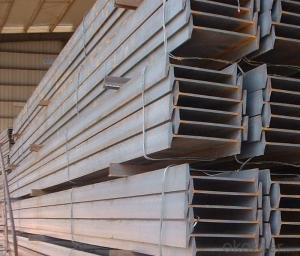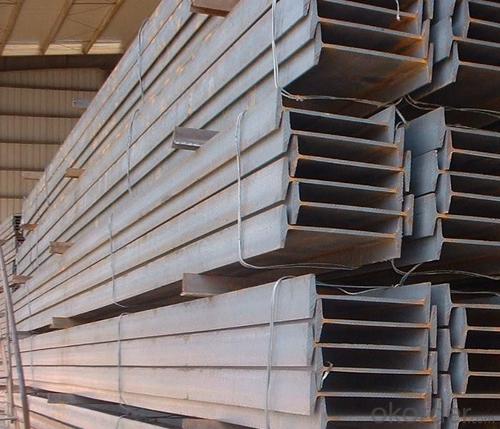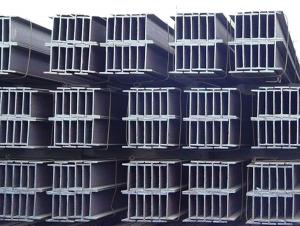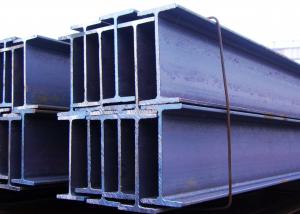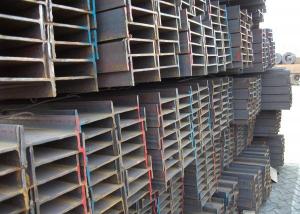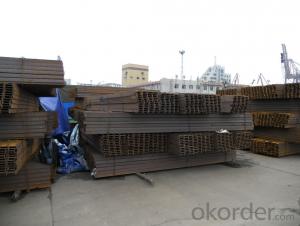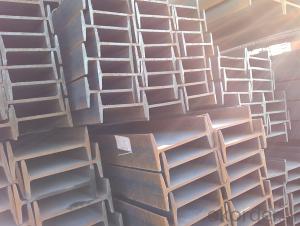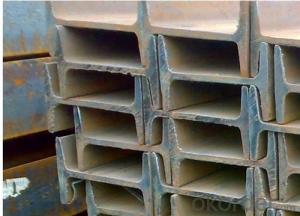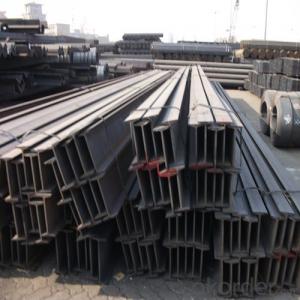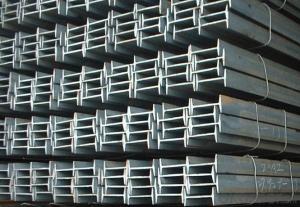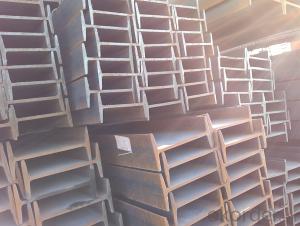Hot Rolled I Beam Steel IPE
- Loading Port:
- China Main Port
- Payment Terms:
- TT or LC
- Min Order Qty:
- -
- Supply Capability:
- -
OKorder Service Pledge
OKorder Financial Service
You Might Also Like
Product Description:
OKorder is offering Hot Rolled I Beam Steel IPE at great prices with worldwide shipping. Our supplier is a world-class manufacturer of steel, with our products utilized the world over. OKorder annually supplies products to European, North American and Asian markets. We provide quotations within 24 hours of receiving an inquiry and guarantee competitive prices.
Product Applications:
Hot Rolled I Beam Steel IPEare ideal for structural applications and are widely used in the construction of buildings and bridges, and the manufacturing, petrochemical, and transportation industries.
Product Advantages:
OKorder's Hot Rolled I Beam Steel IPE are durable, strong, and resist corrosion.
Main Product Features:
· Premium quality
· Prompt delivery & seaworthy packing (30 days after receiving deposit)
· Corrosion resistance
· Can be recycled and reused
· Mill test certification
· Professional Service
· Competitive pricing
Product Specifications:
Manufacture: Hot rolled
Grade: Q195 – 235
Certificates: ISO, SGS, BV, CIQ
Length: 6m – 12m, as per customer request
Packaging: Export packing, nude packing, bundled
Chinese Standard (H*W*T) | Weight (Kg/m) | 6m (pcs/ton) | Light I (H*W*T) | Weight (Kg/m) | 6m (pcs/ton) | Light II (H*W*T) | Weight (Kg/m) | 6M |
100*68*4.5 | 11.261 | 14.8 | 100*66*4.3 | 10.13 | 16.4 | 100*64*4 | 8.45 | 19.7 |
120*74*5.0 | 13.987 | 11.9 | 120*72*4.8 | 12.59 | 13.2 | 120*70*4.5 | 10.49 | 15.8 |
140*80*5.5 | 16.89 | 9.8 | 140*78*5.3 | 15.2 | 10.9 | 140*76*5 | 12.67 | 13.1 |
160*88*6 | 20.513 | 8.1 | 160*86*5.8 | 18.46 | 9 | 160*84*5.5 | 15.38 | 10.8 |
180*94*6.5 | 24.143 | 6.9 | 180*92*6.3 | 21.73 | 7.6 | 180*90*6 | 18.11 | 9.2 |
200*100*7 | 27.929 | 5.9 | 200*98*6.8 | 25.14 | 6.6 | 200*96*6.5 | 20.95 | 7.9 |
220*110*7.5 | 33.07 | 5 | 220*108*7.3 | 29.76 | 5.6 | 220*106*7 | 24.8 | 6.7 |
250*116*8 | 38.105 | 4.3 | 250*114*7.8 | 34.29 | 4.8 | 250*112*7.5 | 28.58 | 5.8 |
280*122*8.5 | 43.492 | 3.8 | 280*120*8.2 | 39.14 | 4.2 | 280*120*8 | 36.97 | 4.5 |
300*126*9 | 48.084 | 3.4 | 300*124*9.2 | 43.28 | 3.8 | 300*124*8.5 | 40.87 | 4 |
320*130*9.5 | 52.717 | 3.1 | 320*127*9.2 | 48.5 | 3.4 | |||
360*136*10 | 60.037 | 2.7 | 360*132*9.5 | 55.23 | 3 |
FAQ:
Q1: Why buy Materials & Equipment from OKorder.com?
A1: All products offered byOKorder.com are carefully selected from China's most reliable manufacturing enterprises. Through its ISO certifications, OKorder.com adheres to the highest standards and a commitment to supply chain safety and customer satisfaction.
Q2: How do we guarantee the quality of our products?
A2: We have established an advanced quality management system which conducts strict quality tests at every step, from raw materials to the final product. At the same time, we provide extensive follow-up service assurances as required.
Q3: How soon can we receive the product after purchase?
A3: Within three days of placing an order, we will begin production. The specific shipping date is dependent upon international and government factors, but is typically 7 to 10 workdays.
Q4: What makes stainless steel stainless?
A4: Stainless steel must contain at least 10.5 % chromium. It is this element that reacts with the oxygen in the air to form a complex chrome-oxide surface layer that is invisible but strong enough to prevent further oxygen from "staining" (rusting) the surface. Higher levels of chromium and the addition of other alloying elements such as nickel and molybdenum enhance this surface layer and improve the corrosion resistance of the stainless material.
Q5: Can stainless steel rust?
A5: Stainless does not "rust" as you think of regular steel rusting with a red oxide on the surface that flakes off. If you see red rust it is probably due to some iron particles that have contaminated the surface of the stainless steel and it is these iron particles that are rusting. Look at the source of the rusting and see if you can remove it from the surface.
Images:
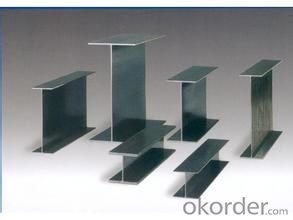
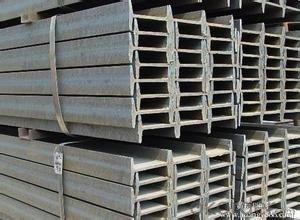
- Q: The tunnel arch sprayed concrete I-beam to dismantle after?
- No, I don't need it! I am a manufacturer of tunnel shotcrete and anchor support equipment. If necessary, give me a contact information! The price will be cheaper than that on the market!
- Q: Can steel I-beams be used in hospitals?
- Yes, steel I-beams can be used in hospitals. Steel I-beams are commonly used in construction due to their strength, durability, and load-bearing capabilities. In hospitals, they can be used to provide structural support for the building, especially in areas that require large open spaces and heavy equipment, such as operating rooms or diagnostic labs. Additionally, steel I-beams can be used to create sturdy and secure frames for doors, windows, and partitions.
- Q: Can steel I-beams be used in schools or educational buildings?
- Yes, steel I-beams can be used in schools or educational buildings. Steel I-beams are commonly used in construction due to their strength, durability, and versatility. They provide structural support and can withstand heavy loads, making them suitable for large educational buildings such as schools. Additionally, steel I-beams allow for open floor plans, facilitating flexible classroom layouts and integration of technology.
- Q: What are the different design considerations for steel I-beams?
- There are several key design considerations for steel I-beams, including the choice of material grade, beam size and shape, load capacity requirements, structural stability, and connections. These considerations ensure the beam's ability to support the required loads, withstand external forces, and maintain structural integrity. Additionally, factors such as deflection, vibration, fire resistance, and corrosion protection must also be taken into account during the design process.
- Q: Can steel I-beams be used for healthcare facilities?
- Healthcare facilities can indeed utilize steel I-beams. These beams, renowned for their strength and durability, are commonly employed in construction and can serve a multitude of purposes, including healthcare facilities. They offer exceptional structural support and can be used to frame walls, floors, and roofs, ensuring the stability and integrity of the building. Moreover, steel I-beams possess fire-resistant properties, a vital attribute in healthcare facilities where safety is paramount. Additionally, steel is a sustainable and recyclable material, aligning perfectly with the burgeoning trend of green building practices in the healthcare industry. All in all, steel I-beams present a reliable and pragmatic choice for the construction of healthcare facilities.
- Q: What is the difference between hot-rolled and cold-formed steel I-beams?
- Hot-rolled and cold-formed steel I-beams differ in their manufacturing processes and resulting structural properties. Hot-rolled steel I-beams are created by heating a billet of steel and passing it through a series of rollers at high temperatures. This process allows for the shaping and forming of the steel while it is still malleable. The high temperatures and pressure involved in hot-rolling make the steel more ductile and easier to work with. As a result, hot-rolled I-beams have a larger section modulus and higher moment of inertia, making them more resistant to bending and deflection. They are typically used in applications where strength and load-bearing capacity are crucial, such as in large-scale construction projects. On the other hand, cold-formed steel I-beams are made by bending or folding a flat sheet of steel at room temperature. This process involves the use of specialized machines to gradually shape the steel into the desired I-beam profile. Cold-forming steel does not involve heating, which makes the process more cost-effective and energy-efficient. However, the lack of heat results in a less ductile material compared to hot-rolled steel. Cold-formed I-beams have a smaller section modulus and lower moment of inertia, making them less resistant to bending and deflection. They are commonly used in applications where lighter loads and structural requirements are present, such as in residential construction or smaller-scale projects. In summary, the main difference between hot-rolled and cold-formed steel I-beams lies in their manufacturing processes and resulting structural properties. Hot-rolled I-beams offer greater strength and load-bearing capacity due to the hot-rolling process, while cold-formed I-beams are more cost-effective and suitable for lighter loads and smaller-scale projects.
- Q: Can steel I-beams be used in interior design or decorative applications?
- Certainly, steel I-beams have multiple applications in interior design and decorative purposes. While their primary use has been in providing support and strength in structural projects, steel I-beams have gained popularity in recent years due to their appealing industrial and modern aesthetic. In the realm of interior design, steel I-beams can be employed to achieve a contemporary and minimalist appearance, introducing architectural intrigue to any space. They can be showcased as exposed beams in loft-style residences, industrial-inspired commercial establishments, or even in traditional settings to add a touch of modernity. Moreover, steel I-beams can serve as sturdy supports for floating shelves, countertops, or even as the foundation for distinctive furniture pieces. With their sleek and robust design, steel I-beams offer versatility and can be customized to match various decorative styles, making them an exceptional choice for interior design and decorative applications.
- Q: Are steel I-beams suitable for load-bearing walls or partitions?
- No, steel I-beams are typically not suitable for load-bearing walls or partitions. Steel I-beams are primarily used as structural support in vertical applications, such as beams in building frames or bridges. They are designed to carry heavy vertical loads, such as the weight of a building or the weight of a bridge. Load-bearing walls or partitions, on the other hand, are designed to carry both vertical and horizontal loads. They need to be able to support the weight of the structure above as well as withstand any lateral forces or loads, such as wind or seismic activity. Load-bearing walls or partitions are usually made of materials that can handle both types of loads, such as concrete, masonry, or wood. These materials have better resistance to lateral forces and are better suited to distribute the load evenly across the wall or partition. While steel I-beams can provide support and reinforcement to load-bearing walls or partitions, they are not typically used as the primary load-bearing element in these applications. Therefore, it is more appropriate to use materials specifically designed for load-bearing walls or partitions rather than steel I-beams.
- Q: What are the considerations for steel I-beam design in high-humidity areas?
- When designing steel I-beams for high-humidity areas, several considerations must be taken into account. Firstly, the choice of materials becomes crucial as exposure to high humidity can lead to corrosion. Therefore, selecting corrosion-resistant steel, such as stainless steel or galvanized steel, is essential. Additionally, proper ventilation and drainage systems should be incorporated to prevent moisture accumulation and minimize the risk of corrosion. Regular inspection and maintenance are also important to identify and address any signs of rust or deterioration promptly. Finally, it is vital to ensure that the design considers the potential impact of humidity on the structural integrity and load-bearing capacity of the steel I-beams.
- Q: Can steel I-beams be used in the construction of bridges?
- Indeed, steel I-beams find extensive application in the realm of bridge construction. Their utilization in this field is widespread owing to their remarkable attributes of strength, durability, and adaptability. Engineered to withstand substantial loads and offer exceptional structural support, these I-beams are ideally suited for spanning vast distances. Moreover, the manufacturing process of steel I-beams enables customization to precise dimensions and specifications, enabling engineers to tailor them to the unique prerequisites of each individual bridge project. Furthermore, the ease with which steel I-beams can be fabricated and transported renders them a cost-effective and pragmatic choice for bridge construction. In summary, the superlative strength, flexibility, and efficacy possessed by steel I-beams render them a favored option when it comes to constructing bridges.
Send your message to us
Hot Rolled I Beam Steel IPE
- Loading Port:
- China Main Port
- Payment Terms:
- TT or LC
- Min Order Qty:
- -
- Supply Capability:
- -
OKorder Service Pledge
OKorder Financial Service
Similar products
Hot products
Hot Searches
Related keywords
